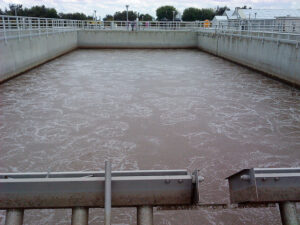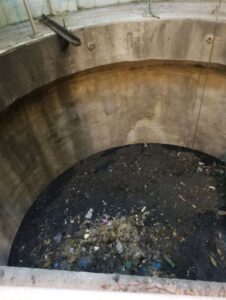Skimming scum off the top of a clarifier water surface and putting it in a scum collection box is a dirty job. Anything that floats, like plastics or grease, rises to the surface during the wastewater clarification process and needs to be removed. Eradicating scum from a wet well in the traditional way is truly a messy job.
Scum Removal in the Traditional Way
 During traditional scum removal processes, wet wells are outfitted with a level control system. This system starts and stops the pumps in the well as the fluid in the well rises and falls. As this happens, the layer of scum that has been building up in the well over time doesn’t get removed because the pit never gets pumped to the bottom. This causes the layer of scum to continue to layer upon itself until the pump operator removes it. This is the intrinsic downside of a wet well.
During traditional scum removal processes, wet wells are outfitted with a level control system. This system starts and stops the pumps in the well as the fluid in the well rises and falls. As this happens, the layer of scum that has been building up in the well over time doesn’t get removed because the pit never gets pumped to the bottom. This causes the layer of scum to continue to layer upon itself until the pump operator removes it. This is the intrinsic downside of a wet well.
Stopping scum build-up requires an operator to use a high-pressure hose to break up the scum layer and mix the loosened debris until it can be pumped out. However, no matter how much this debris is mixed and broken up, the wet well is never totally rid of it. The level control system also becomes coated with floatables and stringy material, creating a stench due to build-up. If the pump fails, it must be removed from the wet well, which is both challenging and a dirty job.
PVP has a Solution to Avoid Stink and Disaster
If you want to avoid the smell of a wet well and all the complications that come along with it, we have a solution for you – get rid of the wet well! By using a double disc pump, you can completely eliminate the wet well, as well as the maintenance and odors that come with it.
When a wet well is eliminated from scum handling, the scum collection box can be piped directly to the suction side of the double disc pump. The enclosed pipe becomes the well. Double disc pump piping is generally 6” or larger so that it can hold the volume during a few rotations from the clarifier mechanism. Double disc pumps have a limit switch trigger located on the clarifier arm. This timing system pumps out all of the contents from the entire line, preventing a build-up of scum. This pump technology has the unique ability to run dry as well as pass large solids and stringy materials.
Double Disc Pump Technology
Double disc pump technology features a ‘non-captive’ free disc design. Two discs are staged in the pump housing and work in unison acting as both the pumping element and valving element. The hydraulic interaction between the discs causes simultaneous vacuum and pressure that moves fluid from suction to discharge. There are no metal external components associated with discs. They have an integral elastomer design.
A short stroke length is created by the pump’s eccentric cams pinned to the drive shaft.
Positive valving occurs with every stroke. The pump’s clack valve offers priming and re-priming aid. It is triggered only when a suction lift condition, or suction line is under a vacuum condition. The pump’s extraordinary design allows it to pass larger solids, rags and debris that would normally cause problems like clogging and failure on other types of pumps.
Benefits of Using a Double Disc Pump
Double Disc pumps are some of the easiest and cleanest pumps to use on the market. They offer:
 Leak free design
Leak free design- No level or float controls required
- No wash down and clean up maintenance needed like with traditional scum pits
- Extremely cost-effective because there is no need for constant operator maintenance of clogged pumps
- Odor free: yes, you read that right, odor free- they eliminate the stink of wet wells
- No regular maintenance since there are only 5 wet end components
- Run dry without causing damage
- Easily pass large solids and semi-solids
- Self-priming and self-valving
- ‘Maintain in Place’ design doesn’t disturb piping when maintenance is needed
When you want to eliminate stink and extra steps in an already lengthy process in wastewater treatment, using a double disc pump is the best option to remove the wet well. This efficient pump design reduces initial capital costs, eliminates routine maintenance, stops odors and saves money in the long run.